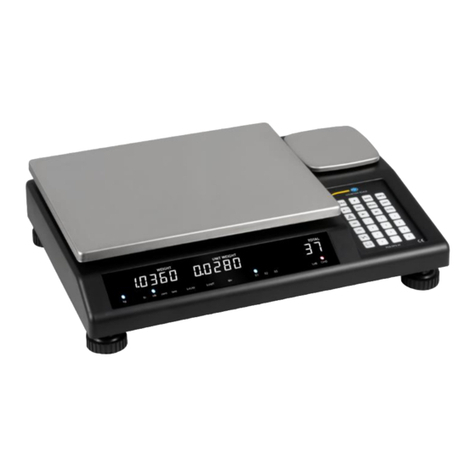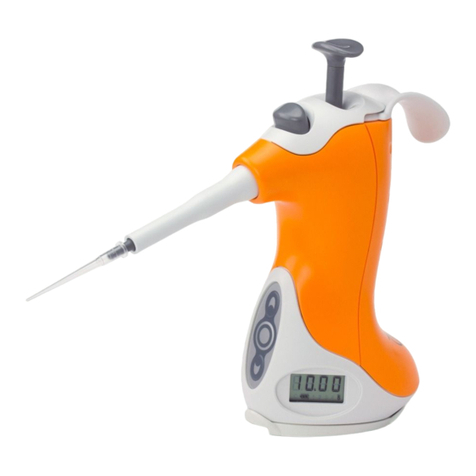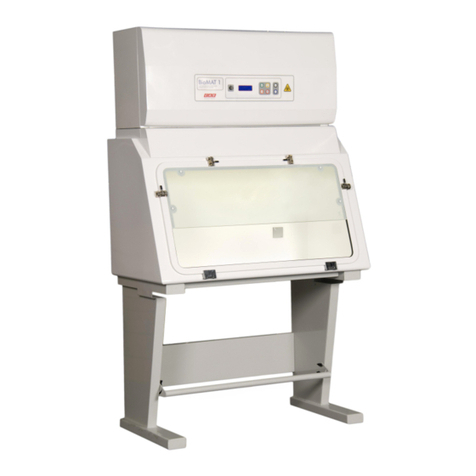Ingenieurburo CAT R 100C User manual

Instruction manual
Betriebsanleitung
Stirring motors
Rührwerke
R 100C, R 100CL and R 100CT

Betriebsanleitung/Instruction Manual R 100C/R 100CL/R 100CT 03/2019 Version 2.6 Page/Seite 2
Content
1USER INSTRUCTIONS.................................................................................................................................................5
1.1 IMPORTANT INSTRUCTIONS FOR YOUR SAFETY......................................................................................................................5
1.2 DANGER SYMBOLS IN THIS OPERATING MANUAL...................................................................................................................5
1.2.1 Danger symbols: ...............................................................................................................................................5
1.2.2 Danger levels.....................................................................................................................................................5
2GENERAL SAFETY WARNINGS AND INSTRUCTIONS ...................................................................................................6
2.1 WARNING SIGNS ON THE DEVICE.......................................................................................................................................7
2.2 WARNING SIGNS ON THE DEVICE.......................................................................................................................................7
3GENERAL INFORMATION ..........................................................................................................................................7
3.1 SCOPE OF DELIVERY........................................................................................................................................................7
4UNPACKING ..............................................................................................................................................................8
5SET-UP ......................................................................................................................................................................8
5.1 ELECTRICAL CONNECTION................................................................................................................................................8
5.2 MOUNTING OF SUPPORT RODS ........................................................................................................................................9
5.3 ATTACH THE OVERHEAD STIRRER TO A STAND .....................................................................................................................9
5.4 ATTACHMENT OF STIRRING PADDLE...................................................................................................................................9
5.5 ASSEMBLING THE SHAFT PROTECTOR...............................................................................................................................10
6SET-UP AND OPERATION.........................................................................................................................................10
6.1 INTENDED USE ............................................................................................................................................................10
6.2 THE FRONT PANEL CONTROLS ........................................................................................................................................11
6.3 DESCRIPTION OF THE FRONT PANEL FUNCTIONS..................................................................................................................12
6.4 DESCRIPTION OF THE REAR PANEL ON THE R100C /R100CL /R100CT..............................................................................13
6.5 STIRRING OPERATION....................................................................................................................................................14
6.6 TIMER CONTROLLED OPERATION .....................................................................................................................................14
7SAFETY FUNCTIONS.................................................................................................................................................15
7.1 ROTOR STUCK DETECTION..............................................................................................................................................15
7.2OVERLOAD PROTECTION................................................................................................................................................15
7.3 OVERTEMPERATURE PROTECTION R100C........................................................................................................................15
7.4 OVERTEMPERATURE PROTECTION R100CL ......................................................................................................................15
7.5 OVER-TEMPERATURE PROTECTION R100CT.....................................................................................................................16
7.6 I/O CONNECTOR (9-PIN SUB-D)....................................................................................................................................16
.......................................................................................................................................................................................16
8THE RS232 INTERFACE OF THE R 100C / R 100CL / R 100CT .....................................................................................17
8.1 RS232 CONNECTION CONFIGURATION BETWEEN PC AND THE R100C /R100CL /R100CT ..................................................18
8.2 FORMAT OF AN RS232-COMMAND ................................................................................................................................18
8.3 FORMAT OF THE CONTROLLER HANDSHAKE.......................................................................................................................19
8.4 RS232 COMMANDS OF THE R100C /R100CL /R100CT................................................................................................20
8.5 PROGRAMMING EXAMPLES ............................................................................................................................................21
8.5.1 Writing parameters to the stirrer ...................................................................................................................21
8.5.2 Reading parameters from the stirrer ..............................................................................................................22
8.6 CONNECTION OF MORE THAN ONE UNIT TO A COMPUTER.....................................................................................................22
9THE SETUP MENU....................................................................................................................................................24
9.1 EXAMPLE:HOW TO CHANGE SETUP SETTINGS....................................................................................................................26
10 ERROR MESSAGES...............................................................................................................................................28
11 CLEANING AND MAINTENANCE...........................................................................................................................28
12 DISMANTLING, TRANSPORT AND STORAGE ........................................................................................................29
12.1 DISMANTLING .............................................................................................................................................................29
12.2 TRANSPORT AND STORAGE ............................................................................................................................................29
13 DISPOSAL ............................................................................................................................................................30

Betriebsanleitung/Instruction Manual R 100C/R 100CL/R 100CT 03/2019 Version 2.6 Page/Seite 3
14 WARRANTY AND LIABILITY..................................................................................................................................30
15 TECHNICAL DATA ................................................................................................................................................31
15.1 TECHNICAL DATA R100C .............................................................................................................................................31
15.2 TECHNICAL DATA R100CL............................................................................................................................................32
TECHNICAL DATA R100CT .......................................................................................................................................................34
16 REPAIRS ..............................................................................................................................................................35
17 APPENDIX A ........................................................................................................................................................35
17.1 DISPLAYING THE SYSTEM INFO: .......................................................................................................................................35
17.2 REPAIR RETURN FORM..................................................................................................................................................36
Inhaltsverzeichnis
18 ALLGEMEINE INFORMATIONEN...........................................................................................................................37
18.1 AUSPACKEN DES GERÄTES .............................................................................................................................................37
18.2 LIEFERUMFANG UND ZUBEHÖR.......................................................................................................................................37
19 SICHERHEITSHINWEISE........................................................................................................................................39
19.1 ERLÄUTERUNG DER SICHERHEITSHINWEISE IN DER GEBRAUCHSANLEITUNG..............................................................................39
19.2 ERLÄUTERUNG DER SICHERHEITSHINWEISE AUF DEM GERÄT.................................................................................................39
19.3 ALLGEMEINE SICHERHEITSHINWEISE ................................................................................................................................40
20 AUFBAU ..............................................................................................................................................................41
20.1 HALTESTANGEN MONTIEREN ..........................................................................................................................................41
20.2 RÜHRWERK AM STATIV BEFESTIGEN.................................................................................................................................41
20.3 RÜHRWERKZEUG MONTIEREN.........................................................................................................................................42
20.4 MONTAGE DES RÜHRWELLENSCHUTZES............................................................................................................................42
21 BEDIENUNG UND BETRIEB...................................................................................................................................43
21.1 BESTIMMUNGSGEMÄßER GEBRAUCH...............................................................................................................................43
21.2 DAS BEDIENFELD .........................................................................................................................................................43
21.3 BESCHREIBUNG DES BEDIENFELDS ...................................................................................................................................44
21.4 BESCHREIBUNG DER RÜCKSEITE DES R100 C/R100CL /R100 CT....................................................................................45
21.5 GERÄT EINSCHALTEN ....................................................................................................................................................46
21.6 ZEITGESTEUERTER BETRIEB DES RÜHRWERKS.....................................................................................................................46
22 SICHERHEITSFUNKTIONEN...................................................................................................................................47
22.1 ROTORBLOCKADE ERKENNUNG.......................................................................................................................................47
22.2 ÜBERLAST-SCHUTZ.......................................................................................................................................................47
22.3 ÜBERTEMPERATURSCHUTZ R100C.................................................................................................................................47
22.4 ÜBERTEMPERATURSCHUTZ R100CT...............................................................................................................................47
22.5 ÜBERTEMPERATURSCHUTZ R100CL ...............................................................................................................................48
22.6 I/O ANSCHLUSS (9-PIN SUB-D).....................................................................................................................................48
.......................................................................................................................................................................................48
23 DIE RS232 SCHNITTSTELLE DES R 100C / R 100CL / R 100CT.................................................................................49
23.1 RS232 ANSCHLUSSKONFIGURATION ZWISCHEN PC UND R100C /R100CL /R100CT ..........................................................50
23.2 FORMAT EINES RS232-BEFEHLS.....................................................................................................................................50
23.3 FORMAT DES CONTROLLER HANDSHAKE...........................................................................................................................51
23.4 RS232 BEFEHLE DES R100C /R100CL /R100CT.........................................................................................................52
23.5 PROGRAMMIERBEISPIELE...............................................................................................................................................53
23.5.1 Schreiben von Parametern zum Rührmotor....................................................................................................53
23.5.2 Auslesen von Parametern aus dem Rührmotor ..............................................................................................54

Betriebsanleitung/Instruction Manual R 100C/R 100CL/R 100CT 03/2019 Version 2.6 Page/Seite 4
23.6 ANSCHLUSS VON MEHR ALS EINEM GERÄT AN DEN COMPUTER .............................................................................................54
24 DAS SETUP MENÜ ...............................................................................................................................................56
24.1 BEISPIEL:ÄNDERUNG DER SETUP EINSTELLUNGEN..............................................................................................................57
25 FEHLERMELDUNGEN ...........................................................................................................................................59
26 REINIGUNG UND WARTUNG ...............................................................................................................................59
27 ABBAU TRANSPORT UND LAGERUNG..................................................................................................................60
27.1 ABBAU.......................................................................................................................................................................60
27.2 TRANSPORT UND LAGERUNG..........................................................................................................................................60
28 ENTSORGUNG .....................................................................................................................................................60
29 GEWÄHRLEISTUNG UND HAFTUNGSAUSSCHLUSS...............................................................................................61
30 TECHNISCHE DATEN ............................................................................................................................................62
30.1 TECHNISCHE DATEN R100C..........................................................................................................................................62
30.2 TECHNISCHE DATEN R100CL........................................................................................................................................63
30.3 TECHNISCHE DATEN R100CT........................................................................................................................................65
31 REPARATUREN ....................................................................................................................................................66
32 APPENDIX A ........................................................................................................................................................66
32.1 ANZEIGE DER SYSTEMINFORMATION:...............................................................................................................................66
32.2 RÜCKSENDEFORMULAR .................................................................................................................................................67
33 DECLARATION OF CONFORMITY / KONFORMITÄTSERKLÄRUNG.........................................................................68

Betriebsanleitung/Instruction Manual R 100C/R 100CL/R 100CT 03/2019 Version 2.6 Page/Seite 5
1 User Instructions
1.1 Important Instructions for your safety
●Every user must read and understand this manual completely before use. Only instructed
users may operate the instrument. Failure to do so can result in serious injury or death.
●Follow general instructions for hazard prevention and general safety instructions, e.g. wear
protection clothing, eye protection and gloves.
●This operating manual is part of the product. Thus, it must always be easily accessible.
●Enclose this operating manual when transferring the device to another place.
●If this manual is lost, please request another one. Please contact your dealer or
Ingenieurbüro CAT
M. Zipperer GmbH
Wettelbrunner Str. 6
D-79282 Ballrechten-Dottingen
Tel.: ++49-(0)7634-5056-800
Fax: ++49-(0)7634-5056-801
www.cat-ing.de
1.2 Danger symbols in this operating manual
The safety instructions in this manual appear with the following danger symbols and danger levels:
1.2.1 Danger symbols:
Hazard point
Electrical shock
Risk of fire
Explosion
Crushing
Bio hazard
1.2.2 Danger levels
Will lead to severe injuries or death
May lead to severe injuries or death
May lead to light to moderate injuries
May lead to material damage

Betriebsanleitung/Instruction Manual R 100C/R 100CL/R 100CT 03/2019 Version 2.6 Page/Seite 6
2 General safety warnings and instructions
Risk of explosion.
●Do not operate the device in the vicinity of highly flammable or explosive substances. The
instrument is not explosion-proof.
●Do not use this device for processing any substances which could generate an explosive
atmosphere.
●Do not use this device to process any explosive or highly reactive substances.
Electric shock as a result of penetration of liquid.
●Do not allow any liquids to penetrate the inside of the housing
●Switch off the device and disconnect the power plug before starting cleaning or disinfection work.
The On/Off Switch on the device does not disconnect the device from the power source.
●Only plug the device back in if it is completely dry, both inside and outside.
Risk from incorrect supply voltage
●Only connect the device to an AC power source with a protective earth (PE).
●Only connect the device to voltage sources which correspondent to the electrical requirements on
the type label.
Electric shock due to damage to device or mains cable
●Only connect the device to the mains supply if the device and the mains cable are
undamaged
●Only use devices that have been properly installed or repaired.
●In case of danger, disconnect the device from the mains supply by pulling the power plug from the
mains socket or by using the isolating device intended for this purpose (e.g. emergency stop switch)
Lethal voltage inside the device
●Do not open the device.
●Ensure that the housing is always closed and undamaged so that no parts inside the housing can
be contacted by accident.
●Do not allow any liquids to penetrate the inside of the housing.
●Repairs are only to be carried out by trained service technicians.
Damages to health due to infectious liquids and pathogenic germs.
●When handling infectious liquids and pathogenic germs, observe the national
regulations, the biological security level of your laboratory, the material safety data sheets and the
manufacturer`s application notes.
●Wear personal protective equipment
●For comprehensive regulations about handling germs or biological material of the risk group II or
higher, please refer to the “Laboratory Biosafety Manual” in its respectively current valid version
from the World Health Organization
Risk of fire
●Do not use this device to process any highly flammable liquids
Damage to health due to contaminated device and accessories
In the following cases, sample material can be released:
- improperly fixed agitator vessels
- unstable vessels
- damaged sealings
- smashed glass vessels
●Only mix in suitable vessels
●Observe the nationally prescribed safety environment when working with hazardous, toxic and
pathogenic samples. Pay particular attention to personal protective equipment (gloves, clothing,
goggles, etc.), extraction, and the safety class of the lab.
●Decontaminate the device and the accessories before storage and shipping.

Betriebsanleitung/Instruction Manual R 100C/R 100CL/R 100CT 03/2019 Version 2.6 Page/Seite 7
Poor safety due to inadequate fixing of the unit
●Ensure that the unit is firmly attached to a solid stand.
Poor safety due to incorrect accessories and spare parts.
The use of accessories and spare parts other than recommended by Ingenieurbüro CAT, M. Zipperer
GmbH may impair the safety, function and precision of the device. Ingenieurbüro CAT, M. Zipperer
GmbH cannot be held liable or accept any liability for damage resulting from the use of incorrect or
non-recommended accessories and spare parts, or from the improper use of such equipment.
●Only use accessories and spare parts recommended by Ingenieurbüro CAT, M. Zipperer GmbH
Crush hazard due to moving parts
●Always use a stirring shaft protector
●Do not replace any consumables as long as the device is running.
●Do not detach the stirring shaft protector as long as the device is running
●Only switch-on the device with properly mounted tools and completely closed stirring shaft
protector.
2.1 Warning signs on the device
This symbol indicates to read the instruction manual carefully prior to operation of the
instrument. Please mark points which require special attention in your field of application
so they are not overlooked. Disregarding of warnings may result in impairment of serviceability as well as
impairment of the user.
2.2 Warning signs on the device
WARNING!
This symbol indicates to read the instruction manual carefully prior to operation of the instrument.
Please mark points which require special attention in your field of application so they are not
overlooked. Disregarding of warnings may result in impairment of serviceability as well as
impairment of the user.
3 General Information
The overhead stirrers R 100C / R 100CL / R 100CT are designed in accordance with Safety
Class 1, and built and tested in accordance with DIN EN 61010.
According to these regulations, the unit is designed to meet the requirements for safe and
correct operations. To maintain the proper safety and operational functions of the instrument,
the user should follow the instructions and safety guidelines in this manual.
3.1 Scope of Delivery
Please check that the package contains the following:
1 Overhead Stirrer R 100C Part No. 60218-0000 (230V) with EU plug or
1 Overhead Stirrer R 100C Part No. 60218-0003 (230V) with UK plug or
1 Overhead Stirrer R 100C Part No. 60218-0001 (115V) with US plug or
1 Overhead Stirrer R 100CT Part No. 60314-0000 (230V) with EU plug or
1 Overhead Stirrer R 100CT Part No. 60314-0003 (230V) with UK plug or
1 Overhead Stirrer R 100CT Part No. 60314-0001 (115V) with US plug or
1 Overhead Stirrer R 100CL Part No. 60315-0000 (230V) with EU plug or
1 Overhead Stirrer R 100CL Part No. 60315-0003 (230V) with UK plug or
1 Overhead Stirrer R 100CL Part No. 60315-0001 (115V) with US plug
2 Support Rods Part No. 10402-0064
1 Chuck key
1 Instruction Manual

Betriebsanleitung/Instruction Manual R 100C/R 100CL/R 100CT 03/2019 Version 2.6 Page/Seite 8
Accessories and stirring tools (optional):
U-Stand Part No. 60494-0000
Special Clamp to fix the unit to a stand Part No. 60495-0000
Stirring shaft protector to be fixed to the stand Part No. 20618-0060
„Jumbo“-Clamp to fix
Stirring shaft protector to the stand Part No. 8B00565000
Y-Cabel for connection of further units via RS232 Part No. 60729-0000
RS 232 Interface cable D-Sub 9pin 1,8m Part No. 30275-0051
USB to RS23 Adapter Part No. 30244-0001
Software Stirrer Control Part No. (upon request)
Please see price list for further accessories such as suitable stirring paddles
4 Unpacking
Unpack the instrument carefully and check to see that it is not damaged. It is important that any
damage incurred in transport be recognized at the time of unpacking. Notify your carrier or forwarding
agent immediately in case of such damage.
- Read this instruction manual carefully before operating the instrument. Should there be any
additional questions, after reading these instructions, concerning the set-up, operation or
warranty, please contact either your distributor, or the manufacturer.
- After reading and understanding the instruction manual you may now start operating the unit.
- Store the instruction manual in a place easily accessible to every user.
5 Set-up
- The units are not to be used in rooms with danger of explosion.
- Do not use this device to process any highly flammable liquids
- The unit is not to be used without supervision.
Please put the unit on to a fire-proof respectively non-combustible even surface.
5.1 Electrical Connection
A earthing-pin plug (DIN 49441 CEE 7/VII10/ 16 A 250 V, a standard plug in Germany, Austria,
the Netherlands, Belgium, France, Norway, Sweden, Finland, Denmark, Portugal and Spain) is
standard on all instruments. For North America instruments feature standard US plugs (NEMA
Pub.No.WDI1961 ASA C 73.1. 1961 page 8 15A 125V),), for the UK with a standard UK plug
BS 1363.
- When operating the instruments in countries with different AC plug systems use an approved
adapter or have a qualified electrician replace the AC plug with an approved model suitable fort
the country of operation.
- The instrument is earthed as supplied. When replacing the original AC plug, ensure that the
earth conductor is connected to the new plug!
- When connecting the instrument to an AC power outlet, ensure that your local supply voltage
matches that indicated on the instrument’s rating plate.
Before connection the instrument to the mains ensure that the rocker switch (1) is set to the „OFF“-
position.

Betriebsanleitung/Instruction Manual R 100C/R 100CL/R 100CT 03/2019 Version 2.6 Page/Seite 9
5.2 Mounting of Support Rods
The device operates with a high torque and vibrated when running. Insufficient
mounted mechanical parts may detach themselves and endanger the health of the
user.
- Ensure that all mechanical connections are firmly tightened.
- Ensure that the unit is firmly attached to a stand.
5.3 Attach the Overhead Stirrer to a Stand
- Ensure that all mechanical connections are firmly tightened.
5.4 Attachment of Stirring Paddle
Insert the stirring paddle (G) into the chuck (F) (as shown in the
picture) and firmly tighten it in the desired position. Use the chuck
key (B) to do so. The immersion depths of the stirring tool may be
adjusted by loosening the chuck (F) and axially moving the stirring
tool.
Support rods
(A)
Chuck key (B)
special clamp (C)
Rod stand (D)
knurled screw (E)
chuck (F)
Stirring paddle (G)
Screw the two support rods (A) (Part
No. 10402-0064) into the threaded
holes at the back of the overhead
stirrer.
(see also Chapter 6.4)
Use the chuck (B) to firmly tighten
them.
Mount the special clamp (Part No. 60495-0000)
to the rod (C) of the stand (D).
Insert the support rods (A) of the overhead stirrer
into the openings of the special clamp (C) and
turn the knurled screws (E) until the drive unit is
firmly attached to the stand.

Betriebsanleitung/Instruction Manual R 100C/R 100CL/R 100CT 03/2019 Version 2.6 Page/Seite 10
5.5 Assembling the Shaft Protector
6 Set-up and Operation
6.1 Intended Use
The R 100C / R 100CL / R 100CT is designed for use in chemical and biological laboratories
of industrial enterprises, universities and pharmacies. It is suitable for stirring and mixing of
liquids from medium to high viscosity. For correct use the device must be fixed to an
appropriate stand.
To ensure maximum service life, observe the specified ambient conditions (temperature and
humidity) and ensure that the instrument is not exposed to a corrosive atmosphere.
The device is not suitable for permanent use
Use a stirring shaft protector
(Part No. 20618-0060) to provide protection
against injury when working with the unit.
Attach the fastening rod (H) of the shaft
protector (M) in front of the chuck to the stand;
e.g. use cross over clamp part no. 60492-0000)
to fix the stirring shaft protector. Now bring the
pockets (K) to the screws (J) and turn the stirring
shaft protector to the left to the limit stop.
The screw (L) is used to adjust the length of the
stirring shaft protector.
Check that the stirring shaft protector is held in
position securely prior to each use and also at
regular intervals. The position of the stirring
shaft protector must only be adjusted when the
unit is stationary and the power supply is
disconnected.
Fastening Rod for Stirring
Shaft Protector (H)
Shaft Protector (M)
Screws (J)
Screw (L)
Bores (K)

Betriebsanleitung/Instruction Manual R 100C/R 100CL/R 100CT 03/2019 Version 2.6 Page/Seite 11
6.2 The Front Panel Controls
The innovative key-pad makes data entry easy and incorporates a 2-line alpha-numeric LCD-
display (1) which shows all relevant data. The entry and changing of timer or setup settings is
made via the setting control knob (5), the motor speed is set with the right speed control knob
(7).
(view on the R 100C / R 100CL / R 100CT front panel)
Power LED (8)
Speed control knob (7)
LCD-Display (1)
Timer LED (2)
Timer
button (3)
Setting control
knob (5)
Load LED (6)
Power on/off
button (9)
Select Display
button (4)

Betriebsanleitung/Instruction Manual R 100C/R 100CL/R 100CT 03/2019 Version 2.6 Page/Seite 12
6.3 Description of the front panel functions
LCD display (1)
The LCD display shows all relevant system data
Timer LED (2)
indicates that timer is active and unit will be automatically
switched off when timer is expired
Timer button (3)
If required, pressing this key initiates the timer function which
will shut down the R 100C / R 100CL / R 100CT. To change
the timer setting use the setting control knob.
The timer is calibrated to show - days : hours : minutes.
Select Display button (4)
Press this key once shortly to step from one display option to
the next.
Press and hold this key for 3 seconds to zero the relative
torque measurement (Mr).
Press and hold this key for at least 5 seconds to switch back
from relative torque measurement (Mr) to absolute torque
measurement (Ma).
(The same applies also to the Power output measurement
function)
Setting control knob (5)
entry and change of timer or setup settings
Load LED(6)
Indicates when the unit is not able to hold set motor speed
due to too high torque taken from motor shaft. Under this
condition the unit will reduce the real motor speed so that the
maximum allowed motor torque is not exceeded.
Speed control knob (7)
setting the speed manually
Power LED(8)
indicates that unit is powered up
Power on/off button (9)
Press this key to turn the unit on or off.

Betriebsanleitung/Instruction Manual R 100C/R 100CL/R 100CT 03/2019 Version 2.6 Page/Seite 13
6.4 Description of the rear panel on the R 100C / R 100CL / R 100CT
(rear view of the R 100C / R 100CL / R 100CT)
9-pole SUB-D connector
In/Output for:
RS232 interface (full duplex)
analogue input for speed setting via voltage signal
input range: 0-10V, operation range programmable
analogue output for speed, torque or power
monitoring.
output range: 0-4V, operation range programmable
mains power supply
make sure that the voltage printed on the R 100C
corresponds to the voltage from your mains !
On the rear panel of the R 100C / R 100CL / R 100CT you will find 2 threads (a) to attach the support
rods (A), a 9-pin SUB-D connector (10), a fan and the mains power supply cable (12).
Support Rod (A)
9-pole SUB-D
connector (10)
Fan (11)
Mains input (12)
Thread (a)
Thread (a)
support rod (A)

Betriebsanleitung/Instruction Manual R 100C/R 100CL/R 100CT 03/2019 Version 2.6 Page/Seite 14
6.5 Stirring operation
- The units are not to be used in rooms with danger of explosion.
- The unit is not to be used without supervision.
- When connecting the instrument to an AC power outlet, ensure that your local supply
voltage matches that indicated on the instrument’s rating plate.
- Avoid splashing of liquids by using a suitable vessel, lower liquid level. Make sure that
suitable protective clothing and eye-wear is used.
- This instruction sheet does not purport to address all of the safety problems which might
result from the use of this instrument, chemicals, reagents, apparatus or equipment
employed in any specific test or protocols. It is the responsibility of the user to consult
their authorised safety advisors and establish appropriate health and safety practices
and then determine the application of regulatory limitations prior to use.
Please put the unit on to a fire-proof respectively non-combustible even surface.
Set the speed setting knob (7) to minimum.
Press the power on/off button (9)
Set the desired motor speed using the speed setting knob (7).
The digital value of the set motor speed can be read out in the top line of the
display (1)
The maximum allowed motor speed can be adjusted / limited in the setup menu
The R 100C / R 100CL / R 100CT has a soft start feature which helps to prevent the liquid from
splashing.
6.6 Timer controlled operation
The Timer function can be activated by pressing the Timer key (3). The Edit arrow appears in
the display (1) and the time can be changed in increments of one minute by turning the setting
control knob (5). If the time is set to zero, the timer function is disabled. If, for example, a time
of ten minutes is selected (00:10:00), the unit will shut down after ten minutes. The readout of
the timer is in: days : hours : minutes
press Timer (3) and then turn the setting control knob (5) to set the desired shut
down time.
The Timer LED signals if the timer is running

Betriebsanleitung/Instruction Manual R 100C/R 100CL/R 100CT 03/2019 Version 2.6 Page/Seite 15
7 Safety Functions
7.1 Rotor stuck detection
If the torque increase versus time exceeds a certain limit the unit will assume that the rotor
was suddenly blocked and will switch off immediately.
Cut-off limit sensitivity can be adjusted in the Set-up menu (Cut off limit)
7.2 Overload protection
If the torque or power drawn from the stirring motor exceeds the allowed range, the unit will
automatically reduce the motor speed until the torque is reduced to the allowed range. If this
happens the LED Load (6) is switched on.
As long as the Load LED (6) is on, the motor is not able to hold the set motor speed.
7.3 Overtemperature protection R 100C
If the temperature inside the unit exceeds the maximum operating temperature, the unit will
automatically reduce power output (speed and torque) in order to get back to a safe
operating point ( = fold back characteristic). This prevents the unit to be destroyed by
constant overload operation. This overload condition is also signalled by the red ´Load´ LED
(6).
Furthermore a cooling fan (11) on the rear side of the instrument is automatically switched on
if required.
If the temperature inside the R 100C exceeds 70°C by any means, the unit will shut down
immediately. This safety feature is fully "redundant". The unit either shuts down if the
microprocessor measures a temperature higher than 70°C, or if the thermo-switch (inside the
R 100C) detects a temperature higher than 70°C.
Important Note:
Before re-starting the unit after cooling down, switch it off and then on again by
using the on/off button.
7.4 Overtemperature protection R 100CL
If the temperature inside the unit exceeds the maximum operating temperature, the unit will
automatically reduce power output (speed and torque) in order to get back to a safe
operating point ( = fold back characteristic). This prevents the unit to be destroyed by
constant overload operation. This overload condition is also signalled by the red ´Load´ LED
(6).
Furthermore a cooling fan (11) on the rear side of the instrument is automatically switched on
if required.

Betriebsanleitung/Instruction Manual R 100C/R 100CL/R 100CT 03/2019 Version 2.6 Page/Seite 16
7.5 Over-temperature protection R 100CT
If the temperature inside the unit exceeds the maximum operating temperature, the unit will
automatically reduce power output (speed and torque) in order to get back to a safe
operating point ( = fold back characteristic). This prevents the unit to be destroyed by
constant overload operation. This overload condition is also signaled by the red ´Load´ LED
(6).
Furthermore a cooling fan (11) on the rear side of the instrument is automatically switched on
if required.
If the temperature inside the R 100CT exceeds 70°C by any means, the unit will shut down
immediately. This safety feature is fully "redundant".
7.6 I/O Connector (9-pin SUB-D)
Pinout of the I/O connector
The following signals are led out on the 9-pin SUB-D connector on the rear side of the
instrument:
RS232 control signals
Analogue input (0-10V) for speed override.
Analogue output (0-4V) for recording of process parameters (speed, torque, power)
Pin Number
Description
1
+ 5V (max. 10mA)
2
TxD
(RS232 transmit data)
3
RxD
(RS232 receive data)
4
n.c.
5
GND
(signal ground)
6
analogue output
(0-4V)
7
n.c.
8
n.c.
9
analogue input
(0-10V)
Socket of the I/O connector (view on socket - 9 pin Sub-D socket)
external
Potentiometer
2200 Ω
(min. 500 Ω)
for speed
override
Pin 5
GND
Pin 1
+5V
Pin 6
out 0 –4V
Pin 9
analogue in 0-10 V

Betriebsanleitung/Instruction Manual R 100C/R 100CL/R 100CT 03/2019 Version 2.6 Page/Seite 17
8 The RS232 interface of the R 100C / R 100CL / R 100CT
The RS232 interface enables remote control of all stirrer functions. In this configuration a
computer can access each connected unit via a sub address (daisy chaining). This address
is programmable for every unit (Setup menu, slave-address).
For daisy-chaining, the transmit line (TxD) of the PC is connected to the receive line (RxD) of
the first unit. The transmit line of this unit is then connected to the receive line of the next unit
in the chain. The transmit line of the last unit in the chain is returned to the receive line of the
PC, which closes the link (ring). You achieve this by using one or more Y cables (PN 60729-
00). For each additional device, you will need a Y-cable, e.g. for 3 devices to be connected, 2
Y-cables are required (see also Chapter 8.6)
For addressing a specific unit in a daisy-chain, each controller carries a so called ´Slave-
address´ which can be any number from 1 to 255. The default slave address is 1.
The slave-address 0 is defined as the general call address on which all controllers will
respond.
The slave-address can be set/changed in the Setup-menu.
A Windows
Software to control a connected unit is optional available.
Parameters of the serial interface (1200-4800,8,N,1):
Baudrate: 1200-4800 Baud (1200 default, see also: Set-up menu)
Databits: 8 Bit
Parity: none
Stopbits: 1
Pinout of the RS232 connector:
Description
pin number
TxD
(transmit
data)
2
RxD
(receive
data)
3
GND
(GROUND)
5
socket of the serial interface (view on socket –female 9 pin Sub-D socket)
Pin 5
GND
Pin 3
RxD
Pin 2
TxD

Betriebsanleitung/Instruction Manual R 100C/R 100CL/R 100CT 03/2019 Version 2.6 Page/Seite 18
8.1 RS232 Connection configuration between PC and the R 100C / R 100CL / R 100CT
a) PC with 9-pin RS232-plug
b) PC with a 25-pin RS232-plug
8.2 Format of an RS232-Command
Each command which is sent to the device must have the format:
ADR , CMDCODE , PARAMETERLIST <CR>
Description:
ADR: Slave Address of the unit to execute the command
CMDCODE: Command-code
PARAMETERLIST:1 to 6 parameters separated by commas
CR: The command string must be terminated by
Carriage/Return (ASCII 13)

Betriebsanleitung/Instruction Manual R 100C/R 100CL/R 100CT 03/2019 Version 2.6 Page/Seite 19
8.3 Format of the Controller Handshake
After receiving a RS232-command the unit will:
1. Send the received command to the next unit (or back to the PC - daisy chaining)
2. Answer with a handshake string, which is defined as follows:
ADR , "HS", RETCODE , PARAMETERLIST CR
Explanation:
ADR: Slave Address of the unit sending the handshake
RETCODE: Errorcode (see table 1 below)
PARAMETERLIST: 1 to 6 parameters, each parameter is separated by a comma "," (see also
table 2, Command codes)
CR the handshake as any command, is terminated by ASCII-code 13 (CR)
Table of return codes:
(Table1)
Return Code
Explanation
Parameter List
OK
command executed, no error
see table 1
UC
unknown command
none
PA
wrong parameter number
(too few or too many parameters
specified)
none
NA
command is not allowed in actual
operation mode
actual operation
mode
PR
at least one parameter is out of
range
none
PL
at least one parameter is too long
none
DF
unknown data format
none

Betriebsanleitung/Instruction Manual R 100C/R 100CL/R 100CT 03/2019 Version 2.6 Page/Seite 20
8.4 RS232 commands of the R 100C / R 100CL / R 100CT
Table 2:
CMD.
CODE
Explanation
Parameter list
Range
RAC
Read actual settings
from the unit
1. Dummy parameter to initiate transfer
-> Controller sends in handshake
A) actual motor speed (rpm)
B) actual torque (relative)
C) actual torque (absolute)
D) actual power (relative)
E) actual power (absolute)
1
WTR
Write Timer
A) Timer value in [sec]
0..2592000
RTR
Read Timer
1. Dummy parameter to initiate transfer
-> Controller sends in handshake:
A) Timer value (seconds)
0 = Timer disabled
1
0..2592000
WSE
Write Motor (SET)
define motor speed
setpoint in rmp´s
A) Motor speed in rpm´s
0 Motor is switched stopped (speed=0)
if selected speed is above allowed limit,
value will be
reduced to allowed limit (Set-up menu,
Max MotorRpm)
0..2000
RSE
Read motor setpoint
(SET)
1. Dummy parameter to initiate transfer
-> Controller sends in handshake:
A) Motor setpoint in rpm
1
0..2000
RSS
Read system status
1. Dummy parameter to initiate transfer
-> Controller sends in handshake:
1. actual systemstatus code
1 normal operation
2. Overload condition
0 no overload condition
1 Motor is under overload operation
1
1
0/1
RTY
Read Type
Information
of unit
1. Dummy parameter to initiate transfer
-> Controller sends in handshake:
A) name of connected device
B) firmware version number
C) ON/OFF counts
D) total operation time in minutes
1
string
string
number
number
WSM
Keyboard or RS232
speed control (Write
serial mode)
Select if setting for
motor speed is
accepted from
frontpanel (speed
control knob) or via
RS232 command
(WSE)
A) Control parameter
0frontpanel control of motor speed
1RS232 control of motor speed (via
WSE command)
0/1
This manual suits for next models
2
Table of contents
Languages:
Popular Laboratory Equipment manuals by other brands
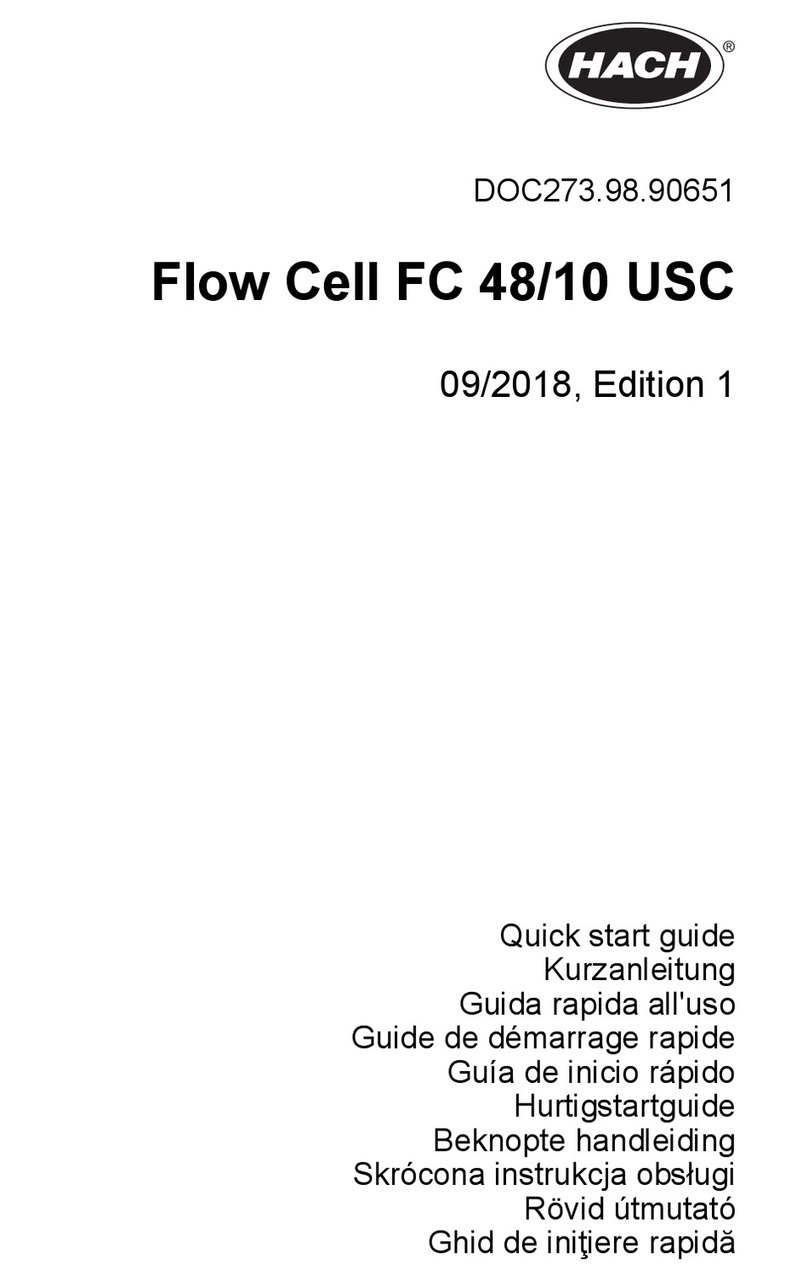
Hach
Hach Flow Cell FC 48/10 USC quick start guide
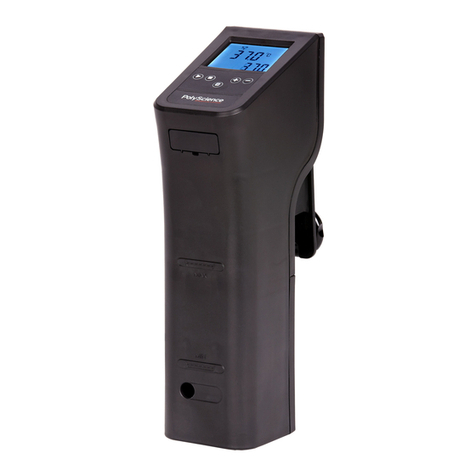
PolyScience
PolyScience LX Immersion Circulator Operator's manual
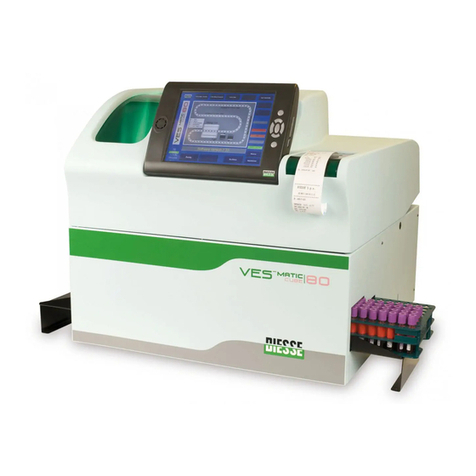
Diesse
Diesse VES MATIC CUBE 80 installation guide

Terumo BCT
Terumo BCT Spectra Optia ESSENTIALS GUIDE
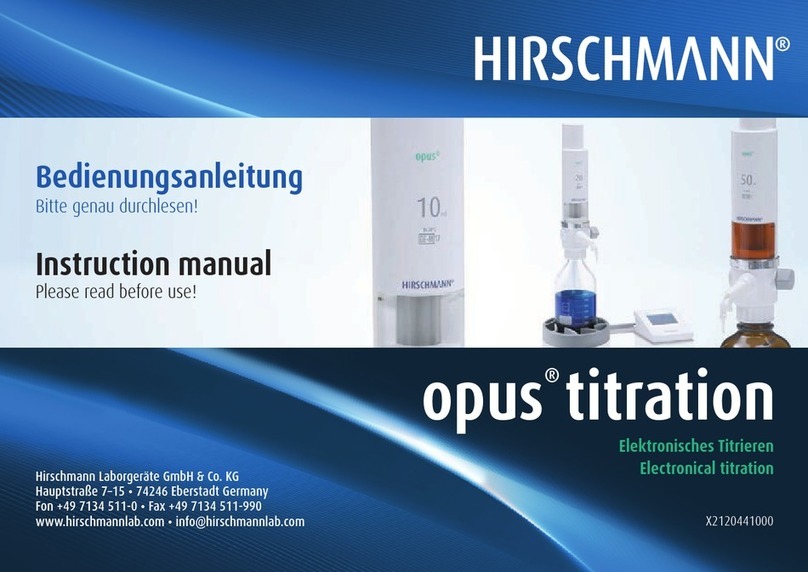
Hirschmann
Hirschmann Opus Titration instruction manual

PASCO
PASCO ME-9207B Instruction manual and experiment guide
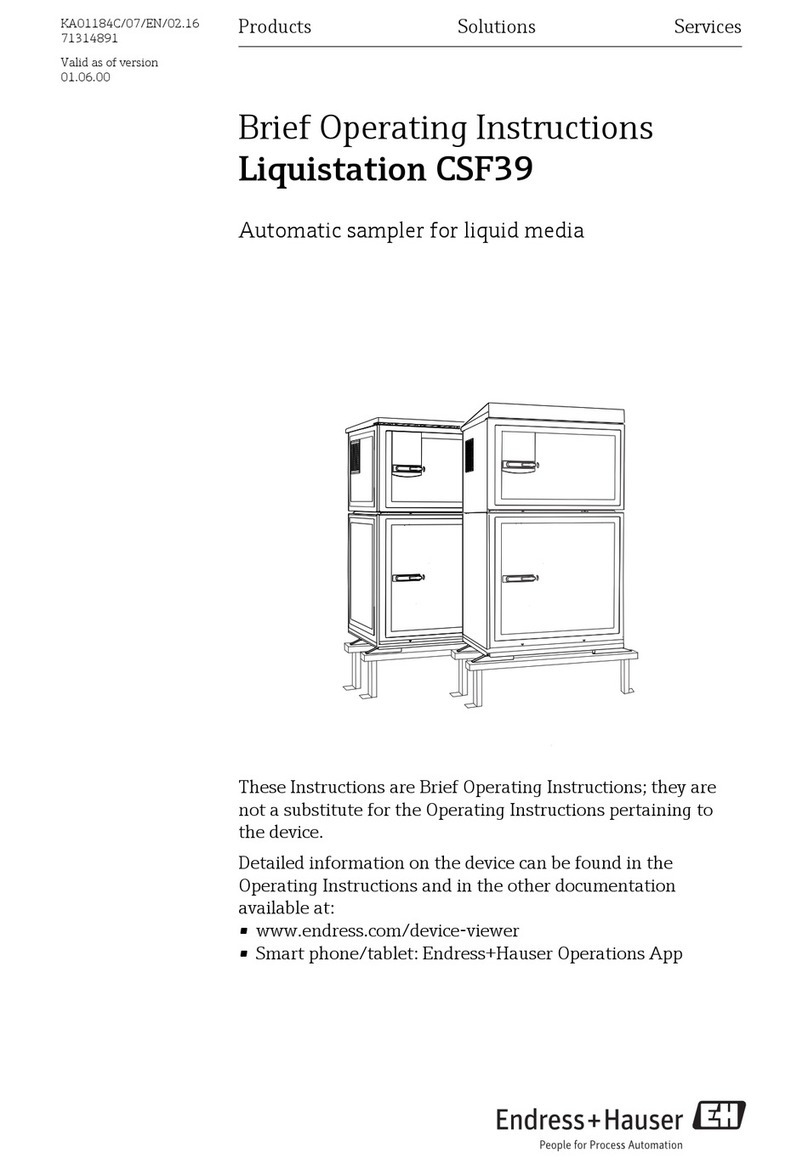
Endress+Hauser
Endress+Hauser Liquistation CSF39 Brief operating instructions
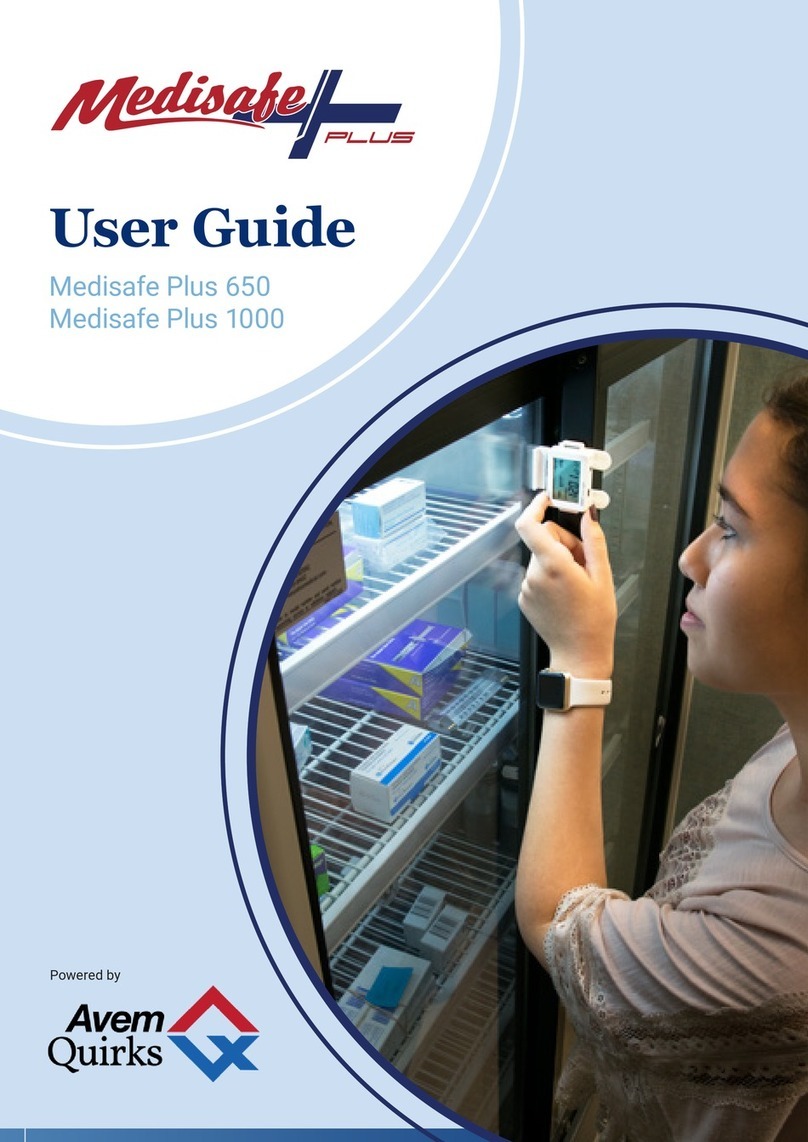
Avem quirks
Avem quirks Medisafe Plus 650 user guide

Thermo Scientific
Thermo Scientific Heraeus Multifuge X3 manual

Life technologies
Life technologies Invitrogen Tali user guide

3M
3M Attest 1496V manual
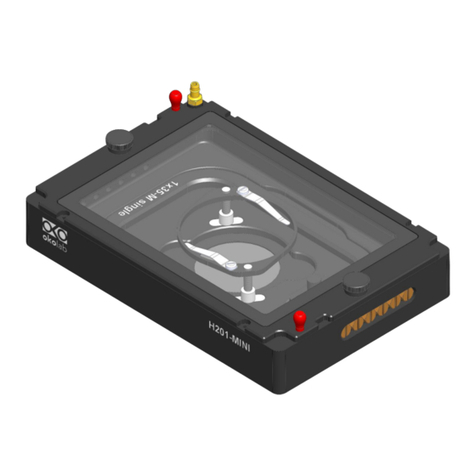
Okolab
Okolab H201-MINI user manual
